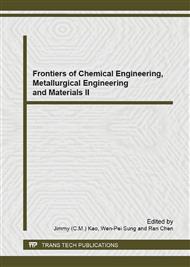[1]
Nie R and Emory R, Probing single molecules and single nanoparticles by surface-enhanced Raman scattering. Science 275: 1102-1106 (1997).
DOI: 10.1126/science.275.5303.1102
Google Scholar
[2]
Moskovits M, Surface-enhanced spectroscopy. Rev. Mod. Phys. 57: 783-826 (1985).
DOI: 10.1103/revmodphys.57.783
Google Scholar
[3]
Atwater HA and Polman A, Plasmonics for improved photovoltaic devices. Nature materials 9: 205-213 (2010).
DOI: 10.1038/nmat2629
Google Scholar
[4]
Kim SS, Na SI, Jo J, Kim DY and Nah YC, Plasmon enhanced performance of organic solar cells using electrodeposited Ag nanoparticles. Appl. Phys. Lett. 93: 073307-073309 (2008).
DOI: 10.1063/1.2967471
Google Scholar
[5]
Morfa AJ, Rowlen KL, Reilly TH, Romero MJ, and Lagemaat J, Plasmon-enhanced solar energy conversion in organic bulk heterojunction photovoltaics. Appl. Phys. Lett. 92: 013504-013506 (2008).
DOI: 10.1063/1.2823578
Google Scholar
[6]
Lindquist NC, Luhman WA, Oh SH, and Holmes R, Plasmonic nanocavity arrays for enhanced efficiency in organic photovoltaic cells. Appl. Phys. Lett. 93: 123308-12310 (2008).
DOI: 10.1063/1.2988287
Google Scholar
[7]
Hagglund C, Zach M and Kasemo B, Enhanced charge carrier generation in dye sensitized solar cells by nanoparticle plasmons. Appl. Phys. Lett. 92: 013113-013115 (2008).
DOI: 10.1063/1.2830817
Google Scholar
[8]
Ferry VE, Verschuuren MA, Li HBT, Schropp REI, Atwater HA, and Polman A, Improved red-response in thin film a-Si: H solar cells with soft-imprinted plasmonic back reflectors. Appl. Phys. Lett. 95: 183503-183505 (2009).
DOI: 10.1063/1.3256187
Google Scholar
[9]
Stuart HR, Hall DG, Absorption enhancement in silicon on insulator waveguides using metal island films. Appl. Phys. Lett, 69: 2327-2329 (1996).
DOI: 10.1063/1.117513
Google Scholar
[10]
Stuart HR, Hall DG, Island size effects in nanoparticle-enhanced photodetectors. Appl. Phys. Lett. 73: 3815-3817 (1998).
DOI: 10.1063/1.122903
Google Scholar
[11]
SCHAADT D M, FENG B, and YU E T. Enhanced semiconductor optical absorption via surface plasmon excitation in metal nanoparticles[J]. Appl Phys Lett, 2005, 86(6): 063106.
DOI: 10.1063/1.1855423
Google Scholar
[12]
DERKACS D, CHEN W V, MATHEU P M, et al. Nanoparticle-induced light scattering for improved performance of quantum-well solar cells[J]. Appl Phys Lett, 2008, 93(9): 091107.
DOI: 10.1063/1.2973988
Google Scholar
[13]
Derkacs D, Lim SH, Matheu P, Mar W and Yu ET, Improved performance of amorphous silicon solar cells via scattering from surface plasmon polaritons in nearby metallic nanoparticles. Appl. Phys. Lett. 89: 093103-093105 (2006).
DOI: 10.1063/1.2336629
Google Scholar
[14]
Derkacs D, Chen WV, Matheu PM, Lim SH, Yu PKL, and Yu ET, Nanoparticle-induced light scattering for improve performance of quantum-well solar cells. Appl. Phys. Lett. 93, 091107-091109 (2008).
DOI: 10.1063/1.2973988
Google Scholar
[15]
Nakayama K, Tanabe K, and Atwater HA, Plasmonic nanoparticle enhanced light absorption in GaAs solar cells. Appl. Phys. Lett. 93, 121904-121906 (2008).
DOI: 10.1063/1.2988288
Google Scholar
[16]
Yang J, You JB, Chen CC, Hsu WC, Tan HR, Zhang XW, Hong Z, and Yang Y, Plasmonic polymer tandem solar cell. Acs nano, 5: 6210-6217 (2011).
DOI: 10.1021/nn202144b
Google Scholar
[17]
Jana NR, Gearheart L and Murphy CJ, Wet Chemical Synthesis of High Aspect Ratio Cylindrical Gold Nanorods. J. Phys. Chem. B 105: 4065-4067 (2001).
DOI: 10.1021/jp0107964
Google Scholar
[18]
Walker CH, John JVS, and Neilson PW, Synthesis and Size Control of Gold Nanoparticles Stabilized by Poly(methylphenylphosphazene). J. Am. Chem. Soc. 123: 3846-3847 (2001).
DOI: 10.1021/ja005812+
Google Scholar
[19]
Chen CD, Yeh YT, Wang CRC, The fabrication and photo-induced melting of networked gold nanostructures and twisted gold nanorods. Journal of Physics and Chemistry of Solids 62: 1587-1597 (2001).
DOI: 10.1016/s0022-3697(01)00098-1
Google Scholar
[20]
Bosbach J, Martin D, Stietz F, Wenzel T, and Trager F, Laser-based method for fabricating monodisperse metallic nanoparticles. Appl. Phys. Lett. 74: 2605-2607 (1999).
DOI: 10.1063/1.123911
Google Scholar
[21]
Chang SS, Shih CW, Chen CD, Lai WC, and Wang CRC, The Shape Transition of Gold Nanorods. Langmuir 15: 701-709 (1999).
DOI: 10.1021/la980929l
Google Scholar
[22]
Felidj N, Aubard J, and Levi G, Controlling the optical response of regular arrays of gold particles for surface-enhanced Raman scattering. Phys. Rev. B 65: 075419-075417 (2002).
DOI: 10.1103/physrevb.65.075419
Google Scholar
[23]
Malinsky MD, Kelly KL, Schatz GC, and Duyne RPV, Nanosphere Lithography: Effect of Substrate on the Localized Surface Plasmon Resonance Spectrum of Silver Nanoparticles. J. Phys. Chem. B 105: 2343-2350 (2001).
DOI: 10.1021/jp002906x
Google Scholar
[24]
Chunyan Duan, Xiaoxia Zhao, Changji Hu, Dongliang Lu and Hui Shen, Preparation of Ag nanoparticles arrays for silicon solar cells, Advance Material Research, (2011).
Google Scholar



